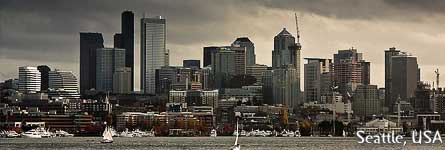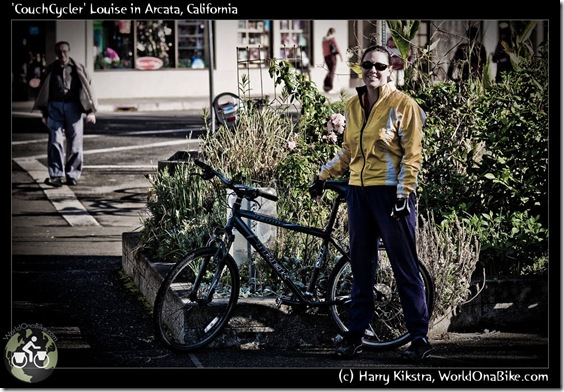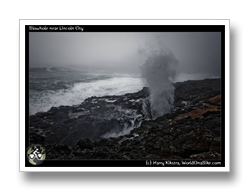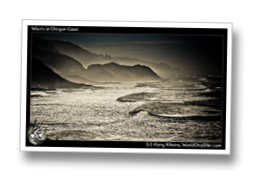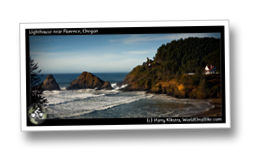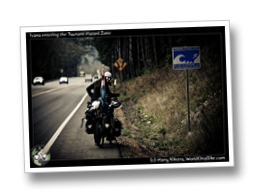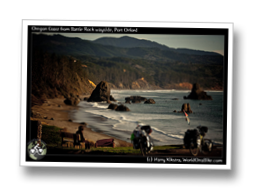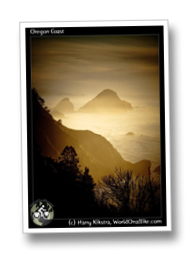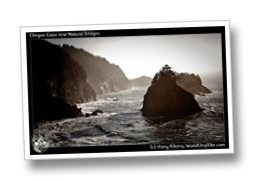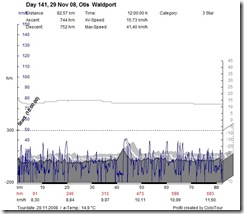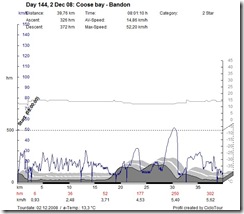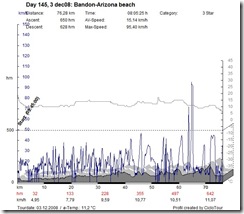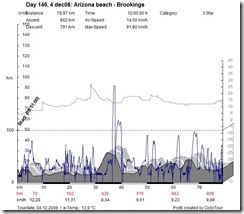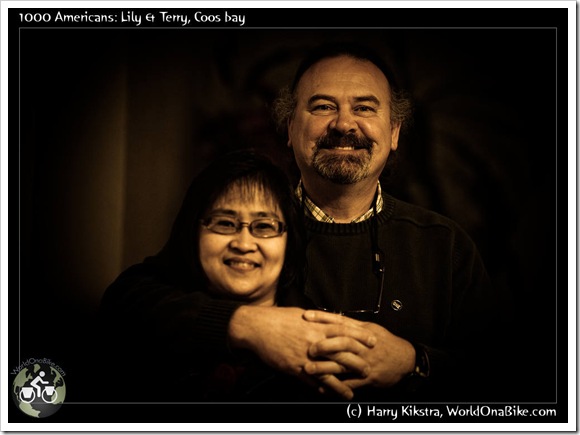1000 Americans: Dub & Beth, Eureka, California
December 12, 2008 by Harry, 718 views
Filed under 1000 Americans
 Actually, Dub’s real name is Dubya, but for obvious reasons Dub & Beth decided that it would be better to call the cat ‘Dub’.
Actually, Dub’s real name is Dubya, but for obvious reasons Dub & Beth decided that it would be better to call the cat ‘Dub’.
They live in a nice place in Eureka, which has a friendly downtown with Victorian-style houses and a nice harbour. Beth loves to host people and does so with a lot of positive energy!
1000 Americans: CouchCycler Louise from McKinleyville, California
December 12, 2008 by Harry, 615 views
Filed under 1000 Americans
Louise, Her Husband Brian and her kids have lived in Malta & Mongolia but are now based in McKinleyville, California.
She loves to ride her bike and came to pick us up on the road when inviting us to stay in her place! next day, we rode together to the city of Arcata, where this picture was taken.
It is great to see that many Californians care about their health and that of the planet and ride bikes everywhere…
1000 Americans: Carol Mone’, Trinidad, California
December 9, 2008 by Harry, 622 views
Filed under 1000 Americans
Carol is a teacher, a profession that is underrated and needed now more than ever. She lives in her favorite place in the world: Trinidad, which is not as Caribbean is it might sound, but very charming nevertheless..
Oh, she is also a great host, with a comfy ‘couch’ ![]() and a collection of flags from all the travellers that have stayed with her. Thanks Carol!
and a collection of flags from all the travellers that have stayed with her. Thanks Carol!
1000 Americans: Loatian Hmong from Minneapolis in Samoa, California
December 9, 2008 by Harry, 1,681 views
Filed under 1000 Americans
Samoa is not only the name of an island in the South Pacific, but also of a very small town in California.
And exactly here is one of the largest gatherings of the Hmong people in the USA, where all American Hmongs gather to celebrate Happy New year, in this case on 7th December of 2008.
This couple, who was selling a large collection of Karaoke DVD’s at the feast, came all the way from their home in Minnesota to celebrate. As Ivana had already met many Hmong during her bicycle trip in South East Asia, I had heard about them.
I asked him, why would a Hmong (Originally from the warmer part of the world), choose to live in Minnesota (not so warm in winter..), but we could not really understand each other.
Back online i started to investigate more and was surprised by the history.
Read the Wikipedia article, it gives a very interesting insight in the South East Asian ethnic group and their involvement in the US foreign politics in the area (Vietnam war etc).
Some quotes:
In the early 1960s, the U.S. Central Intelligence Agency (CIA) began to recruit the indigenous Hmong people in Laos to join fighting the Vietnam War, named as a Special Guerrilla Unit led by General Vang Pao. About 60% of the Hmong men in Laos were supported by the CIA to join fighting for the "Secret War" in Laos.[25] [26] The CIA used the Special Guerrilla Unit as the counter attack unit to block the Ho Chi Minh Trail, the main military supply route from the north to the south. Hmong soldiers put their lives at risk in the frontline fighting for the United States to block the supply line and to rescue downed American pilots. As a result, the Hmong suffered a very high casualty rate; more than 40,000 Hmong were killed in the frontline, countless men were missing in action, thousands more were injured and disabled.
The Secret War began around the time that the U.S. became officially involved in the Vietnam War. Following the U.S. withdrawal from Vietnam in 1975, the Lao kingdom was overthrown by the communists and the Hmong people became targets of retaliation and persecution. While some Hmong people returned to their villages and attempted to resume life under the new regime, thousands more made the trek to and across the Mekong River into Thailand, often under attack. This marked the beginning of a mass exodus of Hmong people from Laos.
Throughout the Vietnam War, and for two decades following it, the U.S. government stated that there was no "Secret War" in Laos and that the U.S. was not engaged in air or ground combat operations in Laos. In the late 1990s, however, several U.S. conservatives, alleging that the Clinton administration was using the denial of this covert war to justify a repatriation of Thailand-based Hmong war veterans to Laos, urged the U.S. government to acknowledge the existence of the Secret War and to honor the Hmong and U.S. veterans from the war. On May 15, 1997, in a total reversal of U.S. policy, the U.S. government acknowledged that it had supported a prolonged air and ground campaign against the NVA and VietCong.
Plans to resettle additional Hmong refugees in the U.S. have been complicated by provisions of President Bush’s Patriot Act and Real ID Act, under which Hmong veterans of the Secret War, who fought on the side of the United States, are classified as terrorists because of their historical involvement in armed conflict.[48]
Many Hmong/Mong refugees resettled in the United States after the Vietnam War. Beginning in December 1975, the first Hmong/Mong refugees arrived in the U.S., mainly from refugee camps in Thailand; however, only 3,466 were granted asylum at that time under the Indochina Migration and Refugee Assistance Act of 1975. In May 1976, another 11,000 were allowed to enter the United States, and by 1978 some 30,000 Hmong/Mong people had immigrated. This first wave was made up predominantly of men directly associated with General Vang Pao‘s secret army. It was not until the passage of the Refugee Act of 1980 that families were able to enter the U.S., becoming the second wave of Hmong/Mong immigrants. Today, approximately 270,000 Hmong/Mong people reside in the United States, the plurality of whom live in California (65,095 according to the 2000 U.S. census), Minnesota (41,800), and Wisconsin (33,791).
Day 141-146, 29-Nov – 4 Dec 2008: The Oregon Coast in photos
December 8, 2008 by Harry, 2,849 views
Filed under North America, Oregon, Trip reports, USA
It took only a few days of cycling to get down the Oregon Coast from Otis, with an average of 72km (45 Mi) we covered it in 6 days. The area is very impressive, even though it was quite rainy and windy, we enjoyed it a lot. Below is a picture overview of some of the scenery we saw along the way.
We also saw some less pretty things, as explained in my previous ‘trash rant’, but overall it was another highlight.
We camped a few days in the rain but also stayed with some wonderful people: Linda & Gilbert, Terry & Lily, Nicole & ‘Jim-Bob’ Brian on Couchsurfing and Ken Neeley, who celebrated our last night in Oregon with us in the local Pizza Place…
Next stop: California!
(click on the images and a larger version will appear automagically!).
Kowalski! Status report!
After 6300km (almost 4000 miles), our Santos Travelmaster bikes are great as ever. Ivana got another flat tire (her 3rd I think), I am still at one!
My back hurts at times and some of the steeper hills I could feel my knees, but so far, so good…
Next stop: California!
1000 Americans: Ken Neeley, Brookings, Oregon
December 5, 2008 by Harry, 805 views
Filed under 1000 Americans
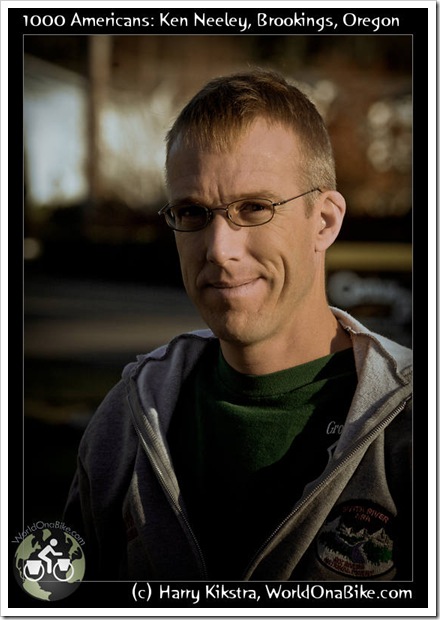 Ken was one of our US Couchsurfing hosts and celebrated our last evening in Oregon by taking us to a nice pizza and beer place!
Ken was one of our US Couchsurfing hosts and celebrated our last evening in Oregon by taking us to a nice pizza and beer place!
It is nice to meet someone who combined his love for the outdoors with his work, as he moved from Arizona and now works in one of the State Parks
Thanks Ken!
1000 Americans: Lily & Terry, Coos Bay
December 2, 2008 by Harry, 561 views
Filed under 1000 Americans
Terry and Lily did not only offer us a warm and dry shelter as well as a wonderful meal, they also taught us a lot about a new way of building houses more ecologically. He showed us examples of Straw bale or Mud houses, ‘green’ houses and all the benefits that come with it (energy efficient, ecological, cheaper, stronger, personalized).
It was very nice to see his passion for the subject and definitely had made us think about any future house we might build…
Mile 207, Oregon Dunes National Recreation Area: a Trash Rant…
I am about to post several wonderful images of Oregon State, USA. A truly beautiful place. But first I have to get something else off my chest:
<rant> Imagine cycling along one of the most beautiful stretches of coastal nature in the US, maybe even in America. Dunes, forests, cliffs and rough waves. So nice they declared it a ‘National Recreation Area’!
I enjoyed the scenery, but got more and more annoyed with the trash that was on the side of the road. It got so bad that I could not focus on the nature or even on the traffic, but just on the next piece of plastic that had been thrown out of a car window, or maybe I should say truck window?
Besides the ugliness of the trash, the chemicals that are slowly released into nature (by decomposing and by getting eaten by animals), it also creates dangerous situations for cyclists, as many times we have to go around heaps of glass or large pieces of trash, forcing me onto the car lane (assuming there is a shoulder to begin with).
At one point, at the bottom of a steep hill, I decided to take some photographs.
About one mile later, I had about 75 pictures of discarded trash, all taken within 45 minutes of uphill cycling (some more were shot after lunch, one hour later). Please take the following facts in account:
- I only started shooting after I got really annoyed by all the trash, so there were hundreds pieces more, just before this series.
- All first 75 shots were taken within 45 minutes; this includes cycling uphill, getting off the bike, releasing the flap of my handlebar-bag, getting the camera ready, taking a picture and getting moving again. Mostly I could do only a few pedal strokes before stopping again.
- Many pieces are missing. Only halfway up I started to shoot ‘doubles’, before, I passed items if I already had shot them. Missed Doubles (or triples) include red Bull, Coca Cola, Camel cigarettes, all Beers Of Idiots (see below) and more
- I did not shoot most unrecognizable and/or unbranded pieces of trash, such as random car parts, plastic wrappers of all kinds and sizes, unrecognizable glass items and much, much, much more…
- The road was steep on my side, the side of this trash, so likely a multitude of trash was to be found lower down the slope
- It was busy and there was no good shoulder, so I could not stop for every piece.
- Image #27 is the one in the middle: Scenic Byway… Besides this sign, there had also been a ‘Adopt-A-Highway sign before I started shooting.
- I only shot one side of the road.
Here is it: all the glory of Mile 207, Oregon (click image for larger version)
Conclusions:
Not all of the below are scientifically proven or valid, but it after cycling several thousand kilometers along the US highways, it is reasonable safe to assume that:
- There are hundreds pieces of trash per mile of US Highway, even though it is in a ‘National Recreation Area’
- Coors & Bud (especially light) are the choice of beer for trash-throwing idiots
- There is just as much ‘healthy’ trash (waters such as Dasani, Aquafina, ArrowHead (with ‘Eco-Shape bottle’!), V8, VitaminWater etc) as there is stuff that was already trash to begin with (KFC, McDonalds, Taco Bell, BurgerKing etc etc)
- Drive-thru coffee creates throw-away empty coffee trash.
- Adopt-a-Highway seems nothing more than a scam where local businesses get some advertising and never look at ‘their’ road again. There were some exceptions in the US (especially notably when the Adopter was a Bikeshop or Eco-market etc), but generally those signs only seemed to attract trash as the idiots throwing things out of their car, seem to need something to aim for..
I assume that the crazy fools that throw these things out of their car window (trust me, they are NOT cyclists…) have zero respect for nature also have no respect for others or even themselves, as they are messing up their own planet. Is is just education? lack of proper values taught by their parents? Or just plain stupidity? I really wonder what goes on in their minds if anything at all.
Some places have a sign that says: ‘$1000 fine for littering’. This means that if one person was stationed here, he could have raised at least $80,000 in fines (likely a multitude) on this one mile alone. I think that will cover his salary? How’s that for job creation?
< / rant>


